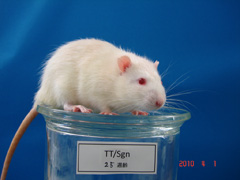| NBRP Rat No: 0597 |
Strain name: TT/Sgn |
Commmon Name: TTラット |
Rat Genome Database |
| Principal Investigator: |
Tomoyuki Tokunaga National Institute of Agrobiological Sciences 2-1-2 Kannondai, Tsukuba 305-8602 Ibaraki Japan |
| Tel: 029-838-7447 Fax: 029-838-7408 |
Email: jgucci@nias.affrc.go.jp |
| Preservation Status: |
Embryo Sperm Living Animals |
 |
![]() |
| Coat Color |
albino (c) |
| Inbred Generations |
F20 (Nov 2009) |
| Usage Restrictions |
In publishing, an acknowledgment to the DEPOSITOR is requested. |
| Genetic Status |
|
| Comercial Availability |
|
|
| Research Category |
|
| Gene Affected |
Fkbp6: FK506 binding protein 6 |
| Origin |
Rats with bilateral small testes were found in a Wistar-Imamichi derived inbred strain in 1986 at the Institute for Animal Reproduction (Ikadai, 1992). TT was established from these mutant rats as known as aspermia rats. (May 31, 2010) |
| Strain characteristics |
Their phenotype is caused by autosomal recessive mutation, as (aspermia). Homozygous mutant males show arrest of spermatogenesis, mainly at the pachytene stage (Ikadai, 1992). Testis weight of mutants was about one-third of that of normal males. A large basophilic inclusion-like body existed in the cytoplasm of late pachytene spermatocytes. The result of spermatogonial transplantation suggested that defective spermatogenesis is caused by defects of both germ cell itself and somatic cell component such as blood-testis barrier (Noguchi, 2002). Heterozygous males and homozygous females are fertile.
aswas revealed to be caused by a genomic deletion including exon 8 of Fkbp6 gene on rat chromosome 12 (Crackower, 2003). (May 31, 2010) |
| Breeding Conditions |
Maintained by crossing between heterozygous males and homozygous or heterozygous females. (May 31, 2010) |
| Genotyping |
Genotyping by PCR analysis. (May 31, 2010) |
| References |
Ikadai H, Noguchi J, Yoshida M, Imamichi T.
An aspermia rat mutant (as/as) with spermatogenic failure at meiosis.
J Vet Med Sci. 1992 Aug;54(4):745-9.
Noguchi J, Toyama Y, Yuasa S, Kikuchi K, Kaneko H.
Hereditary defects in both germ cells and the blood-testis barrier system in as-mutant rats: evidence from spermatogonial transplantation and tracer-permeability analysis.
Biol Reprod. 2002 Sep;67(3):880-8.
Crackower MA, Kolas NK, Noguchi J, Sarao R, Kikuchi K, Kaneko H, Kobayashi E, Kawai Y, Kozieradzki I, Landers R, Mo R, Hui CC, Nieves E, Cohen PE, Osborne LR, Wada T, Kunieda T, Moens PB, Penninger JM.
Essential role of Fkbp6 in male fertility and homologous chromosome pairing in meiosis.
Science. 2003 May 23;300(5623):1291-5. |
| Additional strain information |
|
|
|